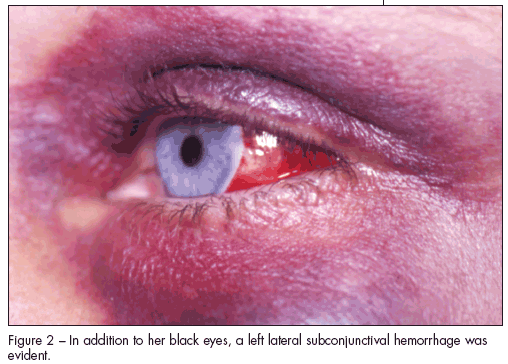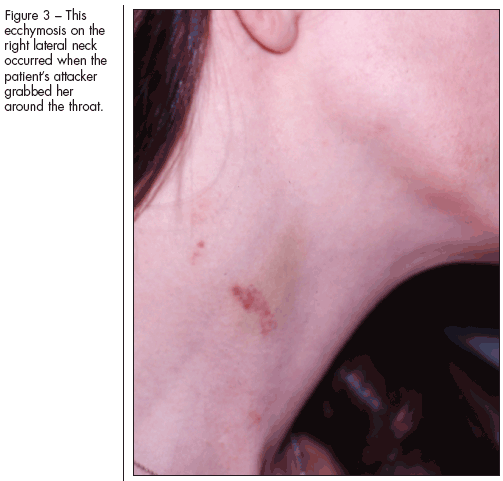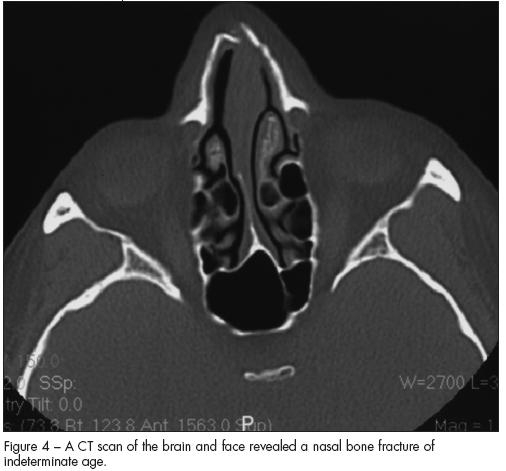- Clinical Technology
- Adult Immunization
- Hepatology
- Pediatric Immunization
- Screening
- Psychiatry
- Allergy
- Women's Health
- Cardiology
- Pediatrics
- Dermatology
- Endocrinology
- Pain Management
- Gastroenterology
- Infectious Disease
- Obesity Medicine
- Rheumatology
- Nephrology
- Neurology
- Pulmonology
Woman With Multiple Head and Neck Injuries
A 35-year-old woman presented to the emergency department (ED) with 2 black eyes, facial swelling, and other injuries (Figure 1). She said that she had been in an all-terrain vehicle accident the day before, in which she hit her face on the handlebar. She said she had lost consciousness for an unknown period and since the accident had experienced headache, dizziness, nausea, and pain over much of her body.
A 35-year-old woman presented to the emergency department (ED) with 2 black eyes, facial swelling, and other injuries (Figure 1). She said that she had been in an all-terrain vehicle accident the day before, in which she hit her face on the handlebar. She said she had lost consciousness for an unknown period and since the accident had experienced headache, dizziness, nausea, and pain over much of her body.

Physical examination revealed left lateral subconjunctival hemorrhage (Figure 2) and ecchymosis on the right lateral neck (Figure 3). She also had ecchymoses on all 4 extremities, her posterior shoulders, posterior neck, and left lumbar and sacral areas. Vital signs were normal.
A head CT scan showed a displaced fracture of the distal tip of the right nasal bone (Figure 4). The fracture was of indeterminate age.
On further questioning by the ED staff, the patient admitted that her injuries had actually been inflicted by her boyfriend, with whom she had lived for 5 years. During an argument the previous night, her boyfriend hit her in the face with his forehead and elbows, grabbed her around the throat and threatened to kill her, and threw her about the room.
For the past 3 years, her boyfriend had assaulted her about once a month, grabbing her and pushing her into the wall. She stated that after these incidents he had always seemed remorseful and begged her forgiveness. His assault the night before was the worst she had ever experienced. She subsequently filed an official complaint with the local police.
INJURIES ASSOCIATED WITH INTIMATE PARTNER VIOLENCE: AN OVERVIEW
Victims of abuse are seldom upfront about the true cause of the injuries they sustain at the hands of their abuser. They often make up stories to explain injuries, agree with the false stories told by their abusers, and deny abuse when directly questioned. Thus, it is especially important to become adept at recognizing the physical signs of abuse.

There is a large body of research on the specific patterns of injury that characterize child abuse (eg, bruising patterns, types of burns, types of orthopedic injuries). Awareness of these injury patterns has proved tremendously helpful to clinicians in their efforts to identify abuse in children. Although an estimated 4.8 million women and 2.9 million men in the United States sustain physical assault from an intimate partner each year,1 there have been far fewer studies of the types, locations, and mechanisms of injury associated with intimate partner violence (IPV).
IPV typically results in head, neck, and facial injuries. In fact, about 90% of victims of IPV present with head and neck injuries,2,3 and IPV is thought to account for between 34% and 73% of all facial injuries in women.4,5
SPECIFIC PATTERNS OF FACIAL INJURY ASSOCIATED WITH IPV
Recently, a study by Arosarena and colleagues6 found specific patterns of facial injury that are more likely to be associated with IPV than with other sources of injury, such as motor vehicle accidents-or even with assault by a stranger. Familiarity with these patterns may help you determine more accurately when heightened suspicion of IPV is warranted, even though a patient may deny any such history.

The investigators reviewed the medical and dental records of 326 women with facial trauma treated by otolaryngologists and oral/maxillofacial surgeons at a university hospital. They found that injuries around the eye or upper face were more likely to be associated with IPV, while mandible fractures were more likely to be caused by assault by an unknown assailant. Victims of IPV more frequently had zygomatic complex fractures, orbital blow-out fractures, and intracranial injuries than did other patients with facial trauma.
Dr David Greene, an otolaryngologist who has studied IPV, notes that this pattern reflects the fact that a woman’s face is the most meaningful area on her person; consequently, hitting in the face figures prominently in IPV.7 This pattern can be contrasted with that typically seen in the assault of a robber, for example, whose goal is to disable the victim.7
Other clues that IPV may be the cause of a patient’s injuries include:
• Injuries that are inconsistent with the method of injury described by the patient.
• Evidence or a history of previous injuries-possibly in different stages of healing. In this woman, for example, her nasal fracture was probably the result of an earlier assault.
• Significant delay between the injury and presentation.
WHAT TO DO IF YOU SUSPECT ABUSE

Intervention can lead to the breaking of a cycle of violence- often, escalating violence-to which a victim is likely to return after she leaves a hospital or clinician’s office. The AMA encourages the reporting of IPV by clinicians and the referral of victims to social service agencies that can provide needed assistance.8
Brief questioning of patients with suspicious injuries can increase the identification of victims of IPV- much as it did in this case. In fact, McLeer and Anwar9 found that most women in such settings respond with relief to questioning about the true cause of their injuries. It is important to have on hand the contact information for appropriate agencies and support services to which women who are victims of IPV can be referred (Box).
INCREASED VIGILANCE NEEDED IN HARD TIMES
The need to be vigilant for signs of IPV-and to intervene when violence is suspected-is especially great in times of economic hardship such as the nation is now experiencing. Economic distress is known to exacerbate IPV.9 The cause of the increase is multifactorial: financial stress often leads to more frequent and more violent abuse; out-of-work husbands and boyfriends are home more and thus have more opportunities to abuse their partners; and women are less likely to leave abusive situations for fear they will not be able to support themselves. Social service agencies in all parts of the country are reporting increases in domestic violence related to the current recession.10-12
REFERENCES:
1.
Tjaden P, Thoennes N. Extent, nature, and consequences of intimate partner violence: findings from the National Violence Against Women Survey. Washington, DC: US Dept of Justice, National Institute of Justice, and CDC; July 2000. Publication NCJ 181867. http://www.ojp.usdoj.gov/nij/pubs-sum/181867.htm.
2.
Shepherd JP, Gayford JJ, Leslie IJ, Scully C. Female victims of assault: a study of hospital atttenders.
J Craniomaxillofac Surg
. 1988;16:233-237.
3.
Greene D, Maas CS, Carvalho G, Raven R. Epidemiology of facial injury in female blunt assault trauma cases.
Arch Facial Plast Surg
. 1999;1:288-291.
4.
Fisher EB, Kraus H, Lewis VL Jr. Assaulted women: maxillofacial injuries in rape and domestic violence.
Plast Reconstr Surg
. 1990;86:161-162.
5.
Zachariades N, Koumoura F, Konsolaki-Agouridaki E. Facial trauma in women resulting from violence by men.
J Oral Maxillofac Surg
. 1990;48:1250-1253.
6.
Arosarena OA, Fritsch TA, Hsueh Y, et al. Maxillofacial injuries and violence against women.
Arch Facial Plast Surg
. 2009;11:48-52.
7.
Lite J. Domestic violence victims have distinct facial injuries, study says.
Scientific American 60-Second Science Blog
.
http://www.scientificamerican.com/blog/60-second-science/post.cfm?d=domestic-violence-victims-have-dist-2009-01-19
. Accessed July 9, 2009.
8.
American Medical Association. Opinions on social policy issues: abuse of spouses, children, elderly persons, and others at risk. In:
Code of Medical Ethics of the American Medical Association: Council of Ethical and Judicial Affairs: Current Opinions With Annotations: 2006-2007 Edition
. Chicago: AMA; 2006:6-8.
9.
McLeer SV, Anwar R. A study of battered women presenting in an emergency department.
Am J Public Health
. 1989;79:65-66.
10.
Benson ML, Fox GL. Economic distress, community context and intimate violence: an application and extension of social disorganization theory. Washington, DC: National Criminal Justice Reference Service, US Dept of Justice. http://www.ncjrs.gov/app/publications/abstract.aspx?id=193434. Accessed July 22, 2009.
11.
Lauby MR, Else S. Recession can be deadly for domestic abuse victims.
The Boston Globe
. December 25, 2008.
www.boston.com/bostonglobe/editorial_opinion/oped/articles/2008/12/25/recession_can_be_deadly_for_domestic_abuse_victims/
Accessed July 22, 2009.
12.
Victims’ advocates say recession contributes to domestic violence. WWL-AM 870/FM 105.3. July 21, 2009.
www.wwl.com/pages/4844081.php
Accessed July 22, 2009.
References:
REFERENCES:
1.
Tjaden P, Thoennes N. Extent, nature, and consequencesof intimate partner violence: findings fromthe National Violence Against Women Survey. Washington,DC: US Dept of Justice, National Institute ofJustice, and CDC; July 2000. Publication NCJ 181867.
http://www.ojp.usdoj.gov/nij/pubs-sum/181867.htm
.
2. Shepherd JP, Gayford JJ, Leslie IJ, Scully C.Female victims of assault: a study of hospital attenders.J Craniomaxillofac Surg. 1988;16:233-237.
3. Greene D, Maas CS, Carvalho G, Raven R. Epidemiologyof facial injury in female blunt assaulttrauma cases. Arch Facial Plast Surg. 1999;1:288-291.
4. Fisher EB, Kraus H, Lewis VL Jr. Assaultedwomen: maxillofacial injuries in rape and domesticviolence. Plast Reconstr Surg. 1990;86:161-162.
5. Zachariades N, Koumoura F, Konsolaki-AgouridakiE. Facial trauma in women resulting from violenceby men. J Oral Maxillofac Surg. 1990;48:1250-1253.
6. Arosarena OA, Fritsch TA, Hsueh Y, et al. Maxillofacialinjuries and violence against women. ArchFacial Plast Surg. 2009;11:48-52.
7. Lite J. Domestic violence victims have distinctfacial injuries, study says. Scientific American 60-Second Science Blog. http://www.scientificamerican.com/blog/60-second-science/post.cfm?id=domestic-violence-victims-have-dist-2009-01-19.Accessed July 9, 2009.
>8. American Medical Association. Opinions on socialpolicy issues: abuse of spouses, children, elderlypersons, and others at risk. In: Code of Medical Ethicsof the American Medical Association: Council ofEthical and Judicial Affairs: Current Opinions WithAnnotations: 2006-2007 Edition. Chicago: AMA;2006:6-8.
9. McLeer SV, Anwar R. A study of battered womenpresenting in an emergency department. Am J PublicHealth. 1989;79:65-66.
10. Benson ML, Fox GL. Economic distress, communitycontext and intimate violence: an applicationand extension of social disorganization theory. Washington,DC: National Criminal Justice Reference Service,US Dept of Justice. http://www.ncjrs.gov/app/publications/abstract.aspx?id=193434. AccessedJuly 22, 2009.
11. Lauby MR, Else S. Recession can be deadly for domestic abuse victims. The Boston Globe. December 25, 2008. http://www.boston.com/bostonglobe/editorial_opinion/oped/articles/2008/12/25/recession_can_be_deadly_for_domestic_abuse_victims. Accessed July 22, 2009.
12. Victims’ advocates say recession contributes todomestic violence. WWL-AM 870/FM 105.3. July 21, 2009. http://www.wwl.com/pages/4844081.php?Accessed July 22, 2009.
